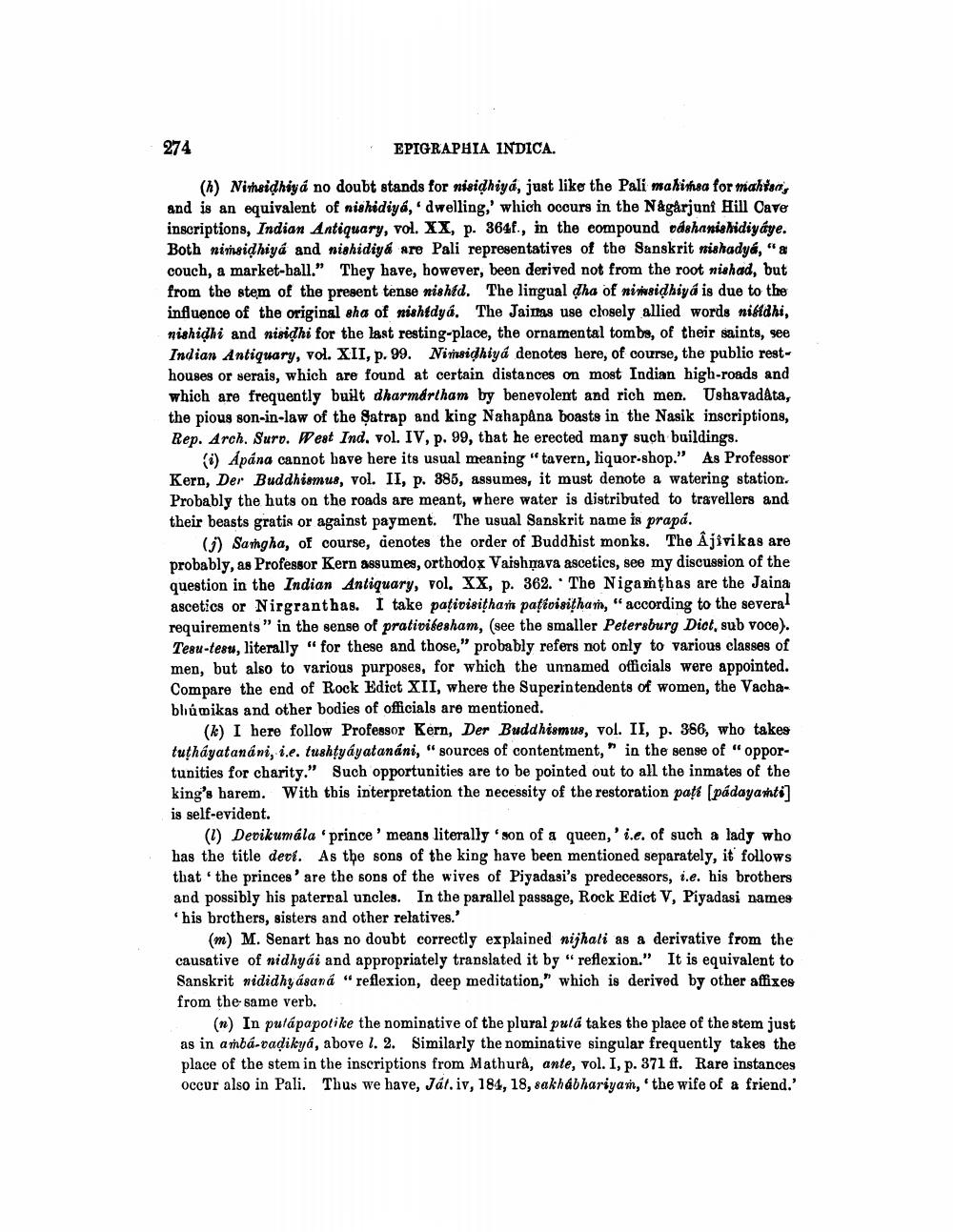________________
274
EPIGRAPHIA INDICA.
(h) Nithsidhiyá no doubt stands for nisidhiya, just like the Pali mahimhsa for mahtaa, and is an equivalent of nishidiya, dwelling,' which occurs in the Någårjuni Hill Cave inscriptions, Indian Antiquary, vol. XX, p. 364f., in the compound vdshanishidiyaye. Both nimsidhiyá and nishidiya are Pali representatives of the Sanskrit nishadya, "a couch, a market-ball." They have, bowever, been derived not from the root nishad, but from the stem of the present tense nishtd. The lingual qha of ninsidhiyá is due to the influence of the original sha of nishidya. The Jairas use closely allied words nifidhi, nishidhi and nisidhi for the last resting-place, the ornamental tombs, of their saints, see Indian Antiquary, vol. XII, p. 99. Nimsidhiya denotes here, of course, the public resthouses or serais, which are found at certain distances on most Indian high-roads and which are frequently built dharmartham by benevolent and rich men. Ushavadata, the pious son-in-law of the Satrap and king Nahapana boasts in the Nasik inscriptions, Rep. Arch. Suro. West Ind. vol. IV, p. 99, that he erected many such buildings.
() Apana cannot have here its usual meaning "tavern, liquor-shop." As Professor Kern, Der Buddhismus, vol. II, p. 385, assumes, it must denote a watering station. Probably the huts on the roads are meant, where water is distributed to travellers and their beasts gratis or against payment. The usual Sanskrit name is prapa.
(1) Sangha, of course, denotes the order of Buddhist monks. The Âjivikas are probably, as Professor Kern assumes, orthodox Vaishnava ascetics, see my discussion of the question in the Indian Antiquary, vol. XX, p. 362. The Nigarthas are the Jaina ascetics or Nirgranthas. I take pațivisithan pațivisitham, "according to the several requirements" in the sense of prativitesham, (see the smaller Petersburg Dict, sub voce).
Tesu-tesu, literally " for these and those," probably refers not only to various classes of men, but also to various purposes, for which the unnamed officials were appointed. Compare the end of Rock Edict XII, where the Superintendents of women, the Vachabhumikas and other bodies of officials are mentioned.
(k) I here follow Professor Kern, Der Buddhismus, vol. II, p. 386, who takes tuthayatanani, i.e. tushțyáyatanani, "sources of contentment," in the sense of "opportunities for charity." Such opportunities are to be pointed out to all the inmates of the king's harem. With this interpretation the necessity of the restoration pati (pádayanti] is self-evident.
(1) Devikumála 'prince' means literally son of a queen,' i.e. of such a lady who has the title deci. As the sons of the king have been mentioned separately, it follows that the princes' are the sons of the wives of Piyadasi's predecessors, i.e. his brothers and possibly his paternal uncles. In the parallel passage, Rock Edict V, Piyadasi names his brothers, sisters and other relatives.'
(m) M. Senart has no doubt correctly explained nijhati as a derivative from the causative of nidhyái and appropriately translated it by "reflexion." It is equivalent to Sanskrit nididhyásaná "reflexion, deep meditation," which is derived by other affixes from the same verb.
(n) In pulápapotike the nominative of the plural putá takes the place of the stem just as in ambá-vadikya, above l. 2. Similarly the nominative singular frequently takes the place of the stem in the inscriptions from Mathura, ante, vol. I, p. 371 ff. Rare instances occur also in Pali. Thus we have, Ját. iv, 184, 18, sakhabhariyam, the wife of a friend.'




